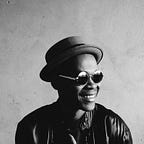Moments into our conversation, I asked Linda Mkhize whether he felt some typa way that he was not being acknowledged by the mainstream for the role he’s played in building many a rapper’s careers; for carving a lane in South African rap, and running its course better and faster than any one else.
His philosophical response caught me off-guard: “That commonly happens. It’s like umunt’ oyenz’ iconstruction. Awumboni. Ei, maar istraat si-grand. It’s always the case. We [emerge] from the distance; we’ve never tried to be kings,” and then: ”We’re peasants man. All a king does is just wake up, stand there and announce to the village, and [head back to] indulge. A peasant sits there, by the gate. [They] can tell when trouble is coming from [a distance], and they’re the ones who make the king important. That’s just my set-up.”
Linda’s known to the urban, peri-urban and rural massive as Pro, and Maqhuzu in SOWETO, the hood he’s carried on his decorated sleeve from the get-go. His debut LP Heads and Tales was the most anticipated event in South African Hip Hop when it got released in 2005. Prior to that, he’d been getting championed by everyone from rapper and esteemed godfather to the scene, Amu, to then-radio broadcaster and one-time Y-Magazine editor Lee Kasumba, who co-hosted a program called Harambe alongside Bad Boy T and Sanza.
Signed on the whim to Gallo Records — “I was number one on [the radio show] Rhyme and Reason for seven weeks. Then uBab’ Sipho Sithole washay’ u-turn [in traffic]…the next thing I knew, ‘I’m announcing this on radio now. I’m signing this boy!’, he recalls — Pro went on to release DNA before switching lanes and signing on to Thembinkosi Nciza and Sbu Leope’s TS Records, at that time the biggest indie label there was, with the mask-donning Kwai-comic Mzekezeke as its premier talent.
My assessment of that follow-up record on Gallo remains; it was sub-par. Pro is more democratic.
“I suppose people weren’t ready. That’s why they can listen to (the first release on TS Records) Dankie San, and then Snakes and Ladders, and then go back to DNA and be like ‘oh shit, oh this is what it was!”
Those initial two albums on Gallo are still available from the iTunes store. This new digital-only reality doesn’t reflect the story afterwards — two releases on TS Records, one of which was certified platinum (Dankie San) — is non-existent.
It feels like erasure; like a chunk of history from one of rap’s most important figureheads has been glazed over by one’s and zero’s, and been buried in sand and covered up by cement by the murky world of licensing and copyright. It’s a reality we find ourselves having to reckon with, now that owning music is spoken of in past tense, unless you’re an older head who still swears by CDs whose plastic-wrapped jewel cases get cracked as you try and peel off the packaging.
Pro was what the underground hip hop conglomerate would refer to as a beast on the mic. He’d run the gamut of park jams and rap ciphers, live shows with shitty soundsystems and little-to-no pay, to get to where he was. He’d paid his dues, and it was his rightful time.
As we converse, it becomes clear that this cat’s as much a scientist as he is an artist. He breaks down his writing process into micro-molecular expeditions through words; he re-arranges flow patterns down to their sub-atomic structure; he possesses both the keen eye of a conscientious camera operator, and the detailed reportage of a chemist mixing an array of chemicals in the lab when manufacturing top-of-the-range products.
“All I wanted to see was more people believe in rapping. But not rapping because siy’thath’ eBopTV. [I wanted to] mirror everything around me. It’s like when an artist sketches, they first have a vision, then they sketch it, then it comes to life. And it’s a beautiful picture. Same with the music,” says Pro.
The formidable working relationship he built with the production house IV League helped to advance his sound and break into previously unexplored territory. Suddenly, Kwaito and House music heads had a firm favourite from the rap world to add onto their music library. I ask how the initial meeting with the team happened.
“The first time was at Capello’s in the CBD. I believe that you can never be larger than life, because you’ll never know where the next thing will come from. When that kid Kiernan spoke to me, I could feel him. I was like okay, fuck this party, let’s go into the car,” he says.
The first beat he heard in that car became “Bhampa”. The Kiernan he speaks of is AKA, then part of IV League alongside Buks and Kamza.
Scrutinizing the list of artists influenced by Pro, directly and indirectly, is another conversation itself, but he’s a busy man.
There’s a new album to be completed. For now though, he’s got an appointment with his fiancé to attend to.
- A version of this article first appeared in the Sunday Times’ Lifestyle section.
